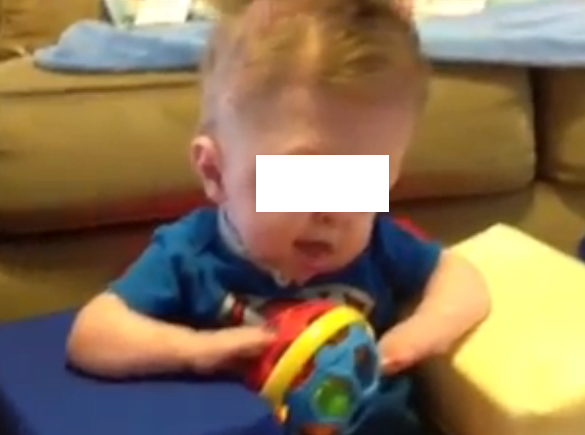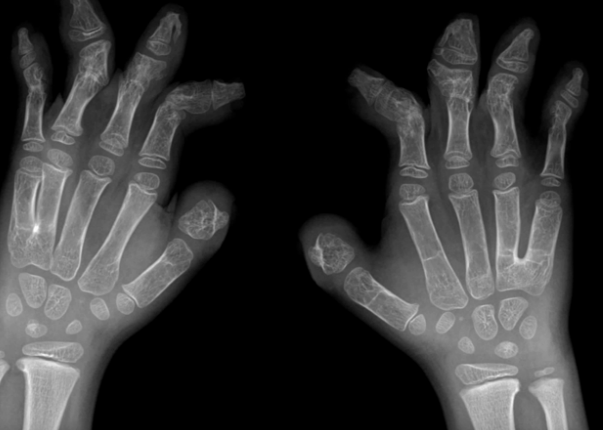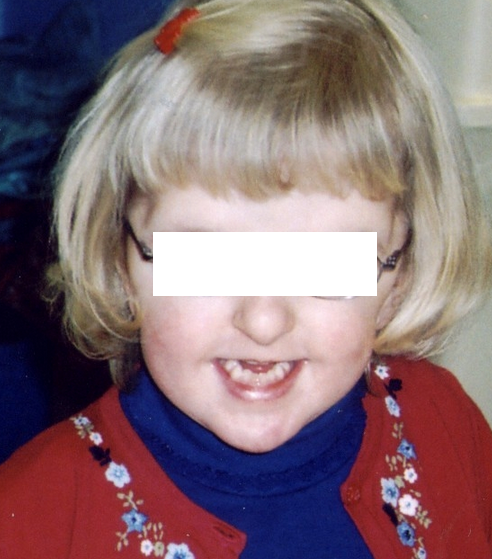Apert Syndrome is an abnormal condition which elicits many different unique characteristics and symptoms. The anomalies associated with Apert syndrome occur because of early union or premature closure of specific joints connecting the skull bones that develop during normal growth of the brain and which divide the skeletal plates. Due to this craniofacial malformation, other body parts are also affected. A child with Apert syndrome also suffers from midface hypoplasia, bicoronal synostosis, and complex syndactyly of the arms and legs.
In midface hypoplasia the growth of the top portion of the face, around 2/3rd of it, is anomalous resulting in an unusual look, teeth problems and other illness like sleep apnea. In case of bicoronal synostosis the coronal stitches of the skull are observed to be merged together, giving an unusual shape to the head as well as substantial increased pressure on the growth of the brain. Complex syndactyly is a state wherein the fingers and toes are attached together as the bones at the tip get fused together.
Treatment of Apert syndrome requires the attention of a special team of surgical and craniofacial medical experts.
Symptoms of Apert syndrome
Some of the symptoms of Apert syndrome are as follows:
- Babies suffering from this abnormality have anomalous skull and upper and lower member/limb defects
- Also, a patient may elicit an unusual shape of the skull; it can be small, elongated, or abnormally wide along with a flat forehead and brow.
- The arms and legs are balanced and in symmetry. However, they may show a series of defects that vary in severity. The fingers may be joined together, with the bones in the tips of the middle, index, and ring fingers merged together. In very severe cases, the thumb may also get fused to the fingers. The hands can look like flat paddles, depending on the type of fusion. The legs also are affected in the same way.
Causes
Apert syndrome occurs rarely; an estimation shows that it can occur in 1 child out of every 45,000 to 160,000 live births.
Mutations or changes in the fibroblast growth factor receptor 2 or FGFR2 gene, which is on chromosome number 10, can result in Apert syndrome. Such errors in the gene can occur at random due to no apparent cause. Hence, parents who are carriers of the abnormal gene may not necessarily pass on the defective gene to the child. It may however be noted that even if only one parent has the genetic mutation associated with Apert syndrome, then there is a fifty percent risk of passing it on to the child.
Increase in paternal age is also considered as a probable risk factor for the development of this disorder. Both men and women are equally vulnerable to Apert syndrome. Transformations in the FGFR2 gene can also result in other skull defects like Crouzon syndrome.
Diagnosis
A doctor will have to fully check the infant’s skull for clear diagnosis of Apert syndrome. The shape of the skull will assist in determining whether stitches have merged. A CT scan proves to be helpful in knowing the condition and structure of the skull. It also helps in getting more intricate and additional details.
X-rays of the child’s arms, spine, hands, legs, and feet, can also assist to verify the analysis. Medical experts may also suggest genetic tests that help in the determination of presence of genetic defects and other erroneous changes in genes, which eventually resulted in Apert syndrome.
Treatment of Apert syndrome
Apert syndrome requires special treatment by a team of surgical and craniofacial medical subspecialists. Treatment includes:
- From the 1st year of life the procedure for hand surgery begins. If the thumbs are merged, then they ought to be released at the earliest, as the thumb is necessary for functioning and development of hand. Various methods are needed and used to free the fingers on each hand. If possible, all digits are divided by about 2 years of age. The feet need surgical treatments in the most severe cases only; for example when it becomes difficult to walk flat, or fit into shoes due to merging of toes, or abnormal positioning of the feet.
- Mostly, the 1st main skull operation is orbital rim advancement and cranial vault remodeling, done at 9 to 11 months of age. In these methods, the skull is restructured to give the brain more space to develop and regularize the look of the skull and upper part of the orbits. A skull surgeon works along with a neurosurgeon to perform this operation.
- In the later periods, the middle portion of the face must be brought forward through an operation called as ‘LeFort III osteotomy.’ This is usually done when the face has grown almost completely, so as to reduce the chances of another facial reconstruction surgery. However, the methods may require to be carried out earlier to tackle problems like severe obstructive sleep apnea which is due to retruded positioning of the midface.
- Skull procedures, like LeFort I osteotomy, are mostly needed to place the upper teeth in the right position with regards to the lower teeth. The upper jaw is moved forward to correct anterior open bite and the underbite. Generally, this method is carried out after the body has fully grown.
Apert Syndrome Pictures




What’s up mates, how is everything, and what you desire to say about this paragraph,
in my view its really amazing for me.
It’s a pity you don’t have a donate button! I’d definitely donate to this outstanding blog!
I guess for now i’ll settle for bookmarking and adding
your RSS feed to my Google account. I look forward to new updates and will talk
about this website with my Facebook group. Talk soon!
Hey There. I found your blog using msn. This is an extremely well written article.
I will be sure to bookmark it and return to read more of your useful info.
Thanks for the post. I will definitely return.
Greetings from California! I’m bored to death at work so I decided to check out your website on my iphone during lunch break.I really like the information you provide here and can’t wait totake a look when I get home. I’m surprised at how fast your blog loaded on my cell phone ..I’m not even using WIFI, just 3G .. Anyways, awesome blog!
Hello there I am so happy I found your blog page, I really
found you by mistake, while I was looking on Yahoo for something else, Regardless I am here now and
would just like to say cheers for a remarkable post and a all round entertaining blog (I also
love the theme/design), I don’t have time to browse it all at the minute but I have bookmarked it and also included your RSS feeds,
so when I have time I will be back to read a lot more, Please do keep up the awesome work.
I was recommended this web site by my cousin. I’m not positive whether this post is written via him asno one else understand such exact about my difficulty.You are amazing! Thank you!
I do believe all the concepts you’ve presented to your post.
They’re very convincing and can definitely work. Still, the posts
are too short for novices. May just you please extend
them a bit from subsequent time? Thank you for the post.
It’s going to be end of mine day, but before finish I am reading this wonderful post to improve my knowledge.
I must thank you for the efforts you have put in penning this blog.
I’m hoping to see the same high-grade blog posts from you later
on as well. In truth, your creative writing abilities has
motivated me to get my own, personal site now 😉
Hello, Neat post. There is an issue with your web sitein web explorer, would check this? IE nonetheless is the marketplace leaderand a big element of people will omit your excellent writingdue to this problem.
Hey there! Would you mind if I share your blog with my myspace group?
There’s a lot of folks that I think would really appreciate your content.
Please let me know. Cheers